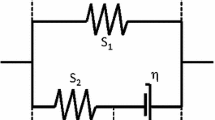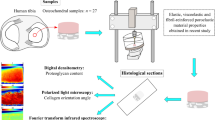Abstract
For this study, we hypothesized that the depth-dependent compressive equilibrium properties of articular cartilage are the inherent consequence of its depth-dependent composition, and not the result of depth-dependent material properties. To test this hypothesis, our recently developed fibril-reinforced poroviscoelastic swelling model was expanded to include the influence of intra- and extra-fibrillar water content, and the influence of the solid fraction on the compressive properties of the tissue. With this model, the depth-dependent compressive equilibrium properties of articular cartilage were determined, and compared with experimental data from the literature. The typical depth-dependent behavior of articular cartilage was predicted by this model. The effective aggregate modulus was highly strain-dependent. It decreased with increasing strain for low strains, and increases with increasing strain for high strains. This effect was more pronounced with increasing distance from the articular surface. The main insight from this study is that the depth-dependent material behavior of articular cartilage can be obtained from its depth-dependent composition only. This eliminates the need for the assumption that the material properties of the different constituents themselves vary with depth. Such insights are important for understanding cartilage mechanical behavior, cartilage damage mechanisms and tissue engineering studies.
Similar content being viewed by others
References
Armstrong CC, Mow VC (1982) Variations in the intrinsic mechanical properties of human articular cartilage with age, degeneration, and water content. J Bone Joint Surg Am 64(1):88–94
Basser PJ, Schneiderman R, Bank RA, Wachtel E, Maroudas A (1998) Mechanical properties of the collagen network in human articular cartilage as measured by osmotic stress technique. Arch Biochem Biophys 351(2):207–219
Benninghoff A (1925) Form und Bau der Gelenkknorpel in ihren Beziehungen zur Funktion. Z Zellforsch 2:783–862
Buckwalter JA, Hunziker EB, Rosenberg LC, Coutts R, Adams M, Eyre D (1991). Articular cartilage: Composition and structure. In: Wo Sl, Buckwalter JA (eds). Injury and repair of musculoskeletal soft tissues. 2nd edn. American Acedemy of Orthopaedic Surgeons, Park Ridge, pp. 405–425
Chahine NO, Wang CC, Hung CT, Atheshian GA (2004) Anisotropic strain-dependent material properties of bovine articular cartilage in the transitional range from tension to compression. J Biomech 37(8):1251–1261
Charlebois M, McKee MD, Buschmann MD (2004) Nonlinear tensile properties of bovine articular cartilage and their variation with age and depth. J Biomech Eng 126(2):129–137
Chen SS, Falcovitz YH, Schneiderman R, Maroudas A, Sah RL (2001) Depth-dependent compressive properties of normal aged human femoral head articular cartilage: relationship to FCD. Osteoarthritis Cartilage 9:561–569
Clark JM (1991) Variation of collagen fiber alignment in a joint surface: a scanning electron microscope study of the tibial plateau in dog, rabbit, and man. J Orthop Res 9:246–257
Clarke IC (1971) Articular cartilage: a review and scanning electron microscope study. 1. The interterritorial fibrillar architecture. J Bone Joint Surg Br 53:732–750
Ehlers W, Eipper G (1999) Finite elastic deformations in liquid-saturated and empty porous solids. Trans Porous Media 34:179– 191
Eisenberg SR, Grodzinsky AJ (1987) The kinetics of chemically induced nonequilibrium swelling of articular cartilage and corneal stroma. J Biomech Eng 109:79–89
Hasler EM, Herzog W, Wu JZ, Muller W, Wyss U (1999) Articular cartilage biomechanics: theoretical models, material properties, and biosynthesis response. Clin Rev Biomech Eng 27:415– 488
Hunziker E (1992). Articular artilage structure in humans and experimental animals. In: Kuettner KE, Peyron JG, Schleyer R, Hascall VC, (eds). articular cartilage and osteoarhritis. Raven Press, New York, pp. 183–199
Hunziker EB, Michel M, Studer D (1997) Ultrastructure of adult human cartilage matrix after cryotechnical processing. Microsc Res Tech 37:271–284
Huyghe JM, Houben GB, Drost MR, van Donkelaar CC (2003) An ionised/non-ionised dual porosity model of intervertebral disc tissue. Biomech Model Mechanobiol 2:3–19
Katz EP, Wachtel EJ, Maroudas A (1986) Extra-fibrillar proteoglycans osmotically regulate the molecular packing of collagen in cartilage. Biochim Biophys Acta 882:136–139
Lanir Y (1987) Biorheology and fluid flux in swelling tissues. I. Bicomponent theory for small deformations, including concentration effects. Biorheology 24:173–187
Lipshitz H, Etheridge R, Glimcher MJ (1975) In vitro wear of articular cartilage. J Bone Joint Surg 57:527–537
Maroudas A (1968) Physicochemical properties of cartilage in the light of ion exchange theory. Biophys J 8:575–595
Maroudas A, Bannon C (1981) Measurement of swelling pressure in cartilage and comparison with the osmotic pressure of constituent proteoglycans. Biorheology 18:619–632
Maroudas A, Wachtel E, Grushko G, Katz EP, Weinberg P (1991) The effect of osmotic and mechanical pressures on water partitioning in articular cartilage. Biochim Biophys Acta 1073:285–294
Meyer FA (1983) Macromolecular basis of globular protein exclusion and of swelling pressure in loose connective tissue (umbilical cord). Biochim Biophys Acta 755:388–399
Mow VC, Guo XE (2002) Mechano-electrochemical properties of articular cartilage: their inhomogeneities and anisotropies. Annu Rev Biomed Eng 4:175–209
Mow VC, Kuei SC, Lai WM, Armstrong CG (1980) Biphasic creep and stress relaxation of articular cartilage in compression: theory and experiments. J Biomech Eng 102:73–84
Mow VC, Zhu W, Ratclife A (1991). Structure and function of articular cartilage and meniscus. In: Mow VC, Hayes WC (eds). Basic orthopaedic biomechanics. Raven Press, New York, pp. 143–198
Rieppo J, Hyttinen MM, Lappalainen R, Jurvelin JS, Helminen HJ (2004) Spatial determination of water, collagen and proteoglycan contents by Fourier transform infrared imaging and digital densitometry. Trans ORS, 1021
Rieppo J, Töyräs J, Nieminen MR, Jurvelin JS, Helminen HJ (2005) Spatial mapping of cartilage collagen and proteoglycans by FT-IRS. Trans ORS, 1484
Sah RL, Yang AS, Chen ACm, Haut JJ, Halili RB, Yoshioka M, Amiel D, Coutts RD (1997) Physical properties of rabbit articular cartilage after transection of the anterior cruciate ligament. J Orthop Res 15(2):197–203
Schinagl RM, Gurskis D, Chen AC, Sah RL (1997) Depth-dependent confined compression modulus of full-thickness bovine articular cartilage. J Orthop Res 15:499–506
Shapiro EM, Borthakur A, Kaufman JH, Leigh JS, Reddy R (2001) Water distribution patterns inside bovine articular cartilage as visualized by 1H magnetic resonance imaging. Osteoarthritis Cartilage 6:533–538
Truesdell C, Toupin R (1960) The classical field theories, Handbuck der Physik II/I. Springer, Berlin Heidelberg New York
Urban JPG, Maroudas A, Bayliss MT, Dillon J (1979) Swelling pressures of proteoglycans at the concentrations found in cartilagenous tissues. Biorheology 16:447–464
Urban JPG, McMullin JF (1988) Swelling pressures of the lumbar intervertebral discs: influence of age, spinal level, composition and degeneration. Spine 13:179–187
Wilson W, van Donkelaar CC, Huyghe JM (2005a) A Comparison between mechano-electrochemical and biphasic swelling theories for soft hydrated tissues. J Biomech Eng 127:158–165
Wilson W, van Donkelaar CC, van Rietbergen B, Huiskes R (2005b) A fibril-reinforced poroviscoelastic swelling (FPVES) model for articular cartilage. J Biomech 38:1195–1204
Wilson W, van Donkelaar CC, van Rietbergen C, Ito K, Huiskes R (2004) Stresses in the local collagen network of articular cartilage: a poroviscoelastic fibril-reinforced finite element study. J Biomech 37:357–366
Wong M, Wuethrich P, Eggli P, Hunziker EB (1996) Zone-specific cell biosynthesis activity in mature bovine articular cartilage: a new method using confocal microscopic stereology and quantitative autoradiography. J Orthop Res 14:424–432
Author information
Authors and Affiliations
Corresponding author
Rights and permissions
About this article
Cite this article
Wilson, W., Huyghe, J.M. & van Donkelaar, C.C. Depth-dependent Compressive Equilibrium Properties of Articular Cartilage Explained by its Composition. Biomech Model Mechanobiol 6, 43–53 (2007). https://doi.org/10.1007/s10237-006-0044-z
Received:
Accepted:
Published:
Issue Date:
DOI: https://doi.org/10.1007/s10237-006-0044-z




